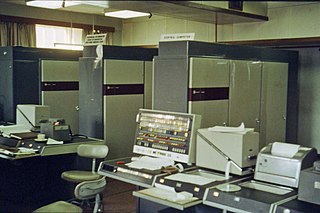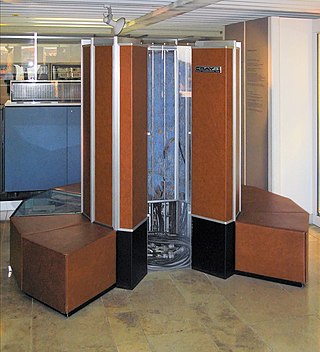
Titan was the prototype of the Atlas 2 computer developed by Ferranti and the University of Cambridge Mathematical Laboratory in Cambridge, England. It was designed starting in 1963, and in operation from 1964 to 1973. [1]

Titan was the prototype of the Atlas 2 computer developed by Ferranti and the University of Cambridge Mathematical Laboratory in Cambridge, England. It was designed starting in 1963, and in operation from 1964 to 1973. [1]
In 1961, the University of Cambridge found itself unable to fund a suitably powerful computer for its needs at the time, so the university purchased from Ferranti the main Atlas processing units and then jointly designed the memory and peripheral equipment. [2] The joint effort led to a cheaper and simpler version of the Atlas that Ferranti could market, leaving Cambridge with the prototype version, named Titan. [2]
The Atlas hardware arrived in Cambridge in 1963, although software design was already underway. [2] David Wheeler was in charge of the joint effort between the university and Ferranti. [2]
In 1965 the Cambridge side of the team decided to add a time-sharing facility for Titan, necessitating the acquisition of additional hardware. [2] When Titan came into full service in 1966, time sharing was available for all staff. [2] Titan was finally switched off in October 1973. [2]
Ferranti, by then a division of International Computers and Tabulators (ICT), marketed the Titan as the Atlas 2. [3] Although intended to be more affordable than the Atlas, its price was still over £1 million. [4] A second Atlas 2 was built in Manchester, and was installed at the Computer-Aided Design Centre (CADCentre) on Madingley Road together with the Cambridge Titan supervisor. This machine, the last Atlas, was finally switched off on 21 December 1976. [5]
A third Atlas 2 was ordered by the UK's Atomic Weapons Research Establishment (AWRE) at Aldermaston. It replaced the faster and much more expensive IBM 7030 Stretch which had been leased from IBM. [6]
Titan differed from the original Manchester Atlas by having a real, but cached, main memory, rather than the paged (or virtual) memory used in the Manchester machine. It initially had 28K of memory, but this was expanded first to 64K and later to 128K. [2] The Titan's main memory had 128K of 48-bit words and was implemented using ferrite core store rather than the part core, part rotating drum-store used on the Manchester Atlas. [5] Titan also had two large hard-disk drives and several magnetic tape decks. [5]
As with the Manchester Atlas, it used discrete components, in particular germanium transistors. Some of these components can be seen in the online relics collection of the University of Cambridge Computer Laboratory. [7]
Titan was the computer on which a team from Ferranti based in Bracknell working with David Barron, David Hartley, Roger Needham and Barry Landy of Cambridge University Maths Lab developed the early multi-user time-sharing operating system called Titan Supervisor. This was arguably the world's first commercially sold time-sharing operating system. [1] [2] Other experiments in time-sharing, such as CTSS and PLATO in the US, were one-of-a-kind research projects.
One of Titan's most intensive uses was to compute the inverse Fourier Transforms of data from the One-Mile Radio Telescope. [5]

The Electronic Delay Storage Automatic Calculator (EDSAC) was an early British computer. Inspired by John von Neumann's seminal First Draft of a Report on the EDVAC, the machine was constructed by Maurice Wilkes and his team at the University of Cambridge Mathematical Laboratory in England. EDSAC was the second electronic digital stored-program computer to go into regular service.

The history of computing hardware covers the developments from early simple devices to aid calculation to modern day computers.

In computing, time-sharing is the sharing of a computing resource among many users at the same time by means of multiprogramming and multi-tasking.

A supercomputer is a computer with a high level of performance as compared to a general-purpose computer. The performance of a supercomputer is commonly measured in floating-point operations per second (FLOPS) instead of million instructions per second (MIPS). Since 2017, there have existed supercomputers which can perform over 1017 FLOPS (a hundred quadrillion FLOPS, 100 petaFLOPS or 100 PFLOPS). For comparison, a desktop computer has performance in the range of hundreds of gigaFLOPS (1011) to tens of teraFLOPS (1013). Since November 2017, all of the world's fastest 500 supercomputers run on Linux-based operating systems. Additional research is being conducted in the United States, the European Union, Taiwan, Japan, and China to build faster, more powerful and technologically superior exascale supercomputers.

The IBM 7030, also known as Stretch, was IBM's first transistorized supercomputer. It was the fastest computer in the world from 1961 until the first CDC 6600 became operational in 1964.

CP/CMS is a discontinued time-sharing operating system of the late 1960s and early 1970s, known for its excellent performance and advanced features. It had three distinct versions:

Sir Maurice Vincent Wilkes was a British computer scientist who designed and helped build the Electronic Delay Storage Automatic Calculator (EDSAC), one of the earliest stored program computers, and who invented microprogramming, a method for using stored-program logic to operate the control unit of a central processing unit's circuits. At the time of his death, Wilkes was an Emeritus Professor at the University of Cambridge.

The Department of Computer Science and Technology, formerly the Computer Laboratory, is the computer science department of the University of Cambridge. As of 2023 it employed 56 faculty members, 45 support staff, 105 research staff, and about 205 research students. The current Head of Department is Professor Ann Copestake.

The University of Cambridge Computing Service provided computing facilities across the University of Cambridge between 1970 and 2014. It was located primarily on the New Museums Site, Free School Lane, in the centre of Cambridge, England but, in September 2013 moved to the Roger Needham Building on the West Cambridge site.

Tom Kilburn was an English mathematician and computer scientist. Over the course of a productive 30-year career, he was involved in the development of five computers of great historical significance. With Freddie Williams he worked on the Williams–Kilburn tube and the world's first electronic stored-program computer, the Manchester Baby, while working at the University of Manchester. His work propelled Manchester and Britain into the forefront of the emerging field of computer science.

z/VM is the current version in IBM's VM family of virtual machine operating systems. z/VM was first released in October 2000 and remains in active use and development as of 2022. It is directly based on technology and concepts dating back to the 1960s, with IBM's CP/CMS on the IBM System/360-67. z/VM runs on IBM's IBM Z family of computers. It can be used to support large numbers (thousands) of Linux virtual machines.
This article covers the History of CP/CMS — the historical context in which the IBM time-sharing virtual machine operating system was built.

The Atlas Computer was one of the world's first supercomputers, in use from 1962 to 1972. Atlas' capacity promoted the saying that when it went offline, half of the United Kingdom's computer capacity was lost. It is notable for being the first machine with virtual memory using paging techniques; this approach quickly spread, and is now ubiquitous.

The Manchester computers were an innovative series of stored-program electronic computers developed during the 30-year period between 1947 and 1977 by a small team at the University of Manchester, under the leadership of Tom Kilburn. They included the world's first stored-program computer, the world's first transistorised computer, and what was the world's fastest computer at the time of its inauguration in 1962.

The Harwell CADET was the first fully transistorised computer in Europe, and may have been the first fully transistorised computer in the world.

The Manchester Mark 1 was one of the earliest stored-program computers, developed at the Victoria University of Manchester, England from the Manchester Baby. Work began in August 1948, and the first version was operational by April 1949; a program written to search for Mersenne primes ran error-free for nine hours on the night of 16/17 June 1949.

The term supercomputing arose in the late 1920s in the United States in response to the IBM tabulators at Columbia University. The CDC 6600, released in 1964, is sometimes considered the first supercomputer. However, some earlier computers were considered supercomputers for their day such as the 1954 IBM NORC in the 1950s, and in the early 1960s, the UNIVAC LARC (1960), the IBM 7030 Stretch (1962), and the Manchester Atlas (1962), all of which were of comparable power.
ICT 1900 was a family of mainframe computers released by International Computers and Tabulators (ICT) and later International Computers Limited (ICL) during the 1960s and 1970s. The 1900 series was notable for being one of the few non-American competitors to the IBM System/360, enjoying significant success in the European and British Commonwealth markets.

The Ferranti Market Research Terminal (MRT) was, arguably, the world’s first application-specific handheld computer. It was designed specifically for the market research sector as a means to augment the regular clipboard schemes that, at the time, were common-place, in social and market research. Despite having an appearance of a calculator built into a clipboard, the reality was that the unit contained a sophisticated form of programmable data-logger that, in response to an interviewer reading questions to the interviewee, had answers digitally recorded (for later uploading and analysis) via pressing appropriate keys on the unit. The unit contained a bespoke operating system to support field based market research. The Ferranti Market Research Terminal (MRT) is also of historical significance to the computing industry since it marked the last original computer design from Ferranti, a long established business (started 1882) that had risen to fame through a collaboration Manchester University to produce the "Mark 1", the world’s first commercial computer and later with Cambridge University producing the "Atlas" and "Titan" computers which, at their peak, held around 25% of the computing market.